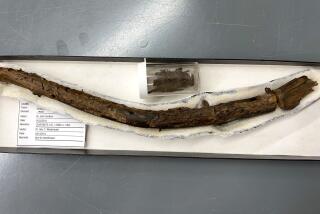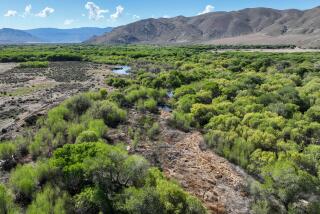Vetch Lives! : Amateurs Rediscover Plant Thought Extinct
SAN FRANCISCO â Robert Sutherland had spent years combing a wooded hillside near Phillipsville, Calif., pursuing an amateur botanistâs greatest challenge: Rediscovering a plant species thought to be extinct.
After an improbable series of events--the felling of a tree to let in some light, the passing of a bulldozer to loosen the soil, a rainstorm in a drought year--a dormant seed sprouted and Sutherland, now joined by two other amateur scientists, happened upon it.
They had rediscovered the rare Humboldt milk vetch.
Sutherlandâs feat--an unusual but not unique accomplishment, say botanists specializing in endangered species--illustrates not only the rather eccentric pursuits of amateur naturalists and the uncertainty of âextinction,â it also shows the potential value of even the most obscure and pedestrian of species.
For the humble Humboldt milk vetch, a plant that even its saviors concede is ânot terribly distinctive,â has drawn the notice of scientists eager to see if the plantâs purported propensity to poison sheep can somehow be tamed and harnessed for medicinal purposes. The attention being heaped upon this obscure little plant-- Astragalus agnicidus --demonstrates the potential benefits scientists imagine when they labor to save even the most arcane species from extinction.
Ken Berg, a botanist for the California Native Plant Society and one of the people who found the milk vetch, said half of todayâs pharmaceuticals were derived from plants and other wild organisms. Still, 90% of all plant species have not yet been tested for their potential benefits.
New plants are discovered by the hundreds every year, Berg said, and unknown numbers are believed to become extinct before they are ever found.
He said that poisonous plants--perhaps including the Humboldt milk vetch--are of special interest to scientists because their active compounds sometimes can be modified or diluted for pharmacological purposes.
Although the milk vetchâs revival was not made public until this week--the Nature Conservancy, a private conservation group sponsoring endangered species research, decided to wait until the new population was well established--the news began circulating through the scientific community a year ago.
Since then, two teams of researchers, from the University of New Mexico and a private research laboratory called World Botanical Associates, have requested samples of the vetch to test for potential pharmaceutical applications. But it may be some time before the requests can be filled.
âThey have asked us for eight pounds of green material,â Berg said, âand there is not that much in the entire world right now.â
There are, in fact, about 100 plants scattered between two sites on a small Phillipsville cattle ranch and a tree farm owned by the Tosten family. A few of the plants are as tall as 13 inches, but others are less than half an inch high.
The scraggly population is nothing like the robust, waist-high clumps that Gordon and Everett Tosten recall pulling from the ground back in the late 1930s and early â40s because a local farm adviser told them that it might be responsible for poisoning the familyâs sheep.
âThe whole family was up there on that hot hillside, rooting that stuff up from the ground,â recalled Gordon Tosten, who now eagerly supports efforts to protect the endangered plant. âThe county (agriculture adviser) never gave us any indication it was rare or anything.â
A sample of the plant eventually was forwarded to the Jepson Herbarium at UC Berkeley, where it was catalogued. Eventually, the sample caught the attention of the countryâs top milk vetch expert, Rupert Barnaby of the New York Botanical Garden, who promptly came to California to inspect it.
âI was preparing a monograph on astragalus, and the only way to know about this one was to come out and look at it,â he explained. âI couldnât leave it out just because it was rare.â
Barnaby said the name astragalus comes from the Greek for anklebone. He said ancient Greeks used such bones in a dice game, and milk vetch seeds make a sound similar to dice in a cup when they rattle around in their pods.
Noting a distinct seed pod that was longer, curvier and hairier than others in the milk vetch family, Barnaby confirmed the existence of a new species and named it âagnicidusâ --from the Latin for âlamb killerâ--based on reports that it had poisoned the animals.
On inspecting the Tosten ranch, however, Barnaby said he noted the presence of another plant, lupine, that he believed more likely to be responsible for poisoning sheep. But the lupine, with pretty blue flowers, didnât look the part of a villain as much as the somewhat homely milk vetch--all woody stems crowned by bundles of small white flowers and hairy seed pods.
It seemed to matter little. That was in 1960, and it was the last confirmed sighting of A. agnicidus for more than 25 years. It appeared, to those who bothered to look, that the milk vetch had vanished.
Evidently some seeds survived. Cloaked in the earth, they waited until the Tosten family quit the sheep business for the logging business. When the Tostens bulldozed a snag, or standing dead tree, in 1987, they disturbed the soil that held the agnicidus seed and opened the forest canopy enough to inspire the sun-loving milk vetch to sprout.
Such comebacks by presumably extinct plants are reported two or three times a year, said John Fay, a U.S. Fish and Wildlife Service plant taxonomist who specializes in endangered plants. Last week, for example, scientists surveying the Pohakuloa Army Training Area in Hawaii found a population of Tetramolopium arenarium, a daisylike plant that was last seen in the 19th Century.
âSaying something is extinct is very tricky, because that is a little like trying to prove a negative,â Fay said. Small plants and insects are especially hard to confirm as extinct, he added, because they are not obvious to casual observers and are easy for even specialists to overlook.
âIâm pretty sure mastodons are extinct,â he said, referring to the giant, prehistoric elephants. âNobody has seen one for a very long time, and theyâre pretty hard to miss. But when you get to some of these small plant species, you always have to take reports of extinction with a very large grain of salt.
âWe are still discovering new species all the time,â he said. âIf theyâve been able to escape notice for 200 years (when botanists began looking for species in earnest), itâs possible for us to miss (a known species) for 80 or 90 years and think it is extinct.â
Such talk inspires and motivates hundreds of amateur naturalists around the country. Like Sutherland, they spend their weekends and vacations scouring the land for long-missing species.
Berg, of the California Native Plant Society, said that more than 200 volunteers in California alone regularly report sightings of rare plants. Spotting plants believed to be extinct is a particular challenge, Berg said.
âIt is very exciting, looking for extinct plants,â he said. âIt involves detective work, finding out who saw it last and where, and then you go out and sleuth around for it.â
Exciting or not, it works. Berg said that in the 15 years since the society published its âInventory of Rare and Endangered Vascular Plants of California,â 30 plants once believed extinct have been found in the state.
These revivals are logged by the Natural Diversity Data Base in Sacramento, a joint project of the state Department of Fish and Game, the Native Plant Society of California and the Nature Conservancy. The conservancy has helped establish similar services in 48 other states and is working on one in Alaska.
Another 38 plants remain on the list of California species âpresumed to be extinct,â and Berg said that more are being added all the time as cities expand and cattle graze and forests fall to the loggerâs chainsaw.
But 200 tips a month pour into the Natural Diversity Data Base, a statistic that cheers the professional scientists who worry about how the growing number of extinctions being recorded will affect the planetâs biological diversity.
âMost of us think of it as a generalized insurance policy,â he said. âWe know that if you lose enough parts of the ecological system, it will crash. We donât know how many parts we can lose before it crashes or how each of the parts relate to one another, so it is wise to save as much as we can.â






